The Impact of Diesel/LPG Dual Fuel on Performance and Emissions in a Single Cylinder Diesel Generator
Abstract
:1. Introduction
2. Materials and Methods
2.1. Experimental Fuels
2.2. Test Engine
2.3. Installation Modifications
2.4. Test Procedure
3. Results and Discussion
4. Conclusions
Author Contributions
Conflicts of Interest
Nomenclature
| BSFC | Brake specific fuel consumption (g/kWh) |
| CA | Crank Angle |
| CLD | Chemiluminescence detector |
| CO | Carbon monoxide |
| CW | Clock wise |
| CCW | Counter clock wise |
| CNG | Compressed natural gas |
| DME | Diesel Methyl Ester |
| D-100 | Diesel fuel |
| ECU | Electronic control unit |
| EGT | Exhaust gas temperature |
| HC | Hydrocarbon |
| GDI | Gasoline direct injection |
| LPG | Liquefied petroleum gas |
| LPG-30 | %30 LPG + %70 Diesel fuel |
| LPG-50 | %50 LPG + % 50 Diesel fuel |
| LPG-70 | %70 LPG + %30 Diesel fuel |
| NDIR | Non-dispersive infrared |
| NOx | Nitrogen oxide |
| PM | Particulate matter |
| TDF | Tire Derived Fuel |
| η | Effective efficiency (%) |
| mf | Fuel consumption per hour (kg/h) |
| LVH | Lower heating value (kJ/kg) |
| Pe | Effective engine power (kW) |
References
- Selim, M.Y.; Radwan, M.S.; Saleh, H.E. Improving the performance of dual fuel engines running on natural gas/LPG by using pilot fuel derived from jojoba seeds. Renew. Energy 2008, 33, 1173–1185. [Google Scholar] [CrossRef]
- Ramadhas, A.S.; Muraleedharan, C.; Jayaraj, S. Performance and emission evaluation of a diesel engine fueled with methyl esters of rubber seed oil. Renew. Energy 2005, 30, 1789–1800. [Google Scholar] [CrossRef]
- Rakopoulos, C.D.; Antonopoulos, K.A.; Rakopoulos, D.C.; Hountalas, D.T.; Giakoumis, E.G. Comparative performance and emissions study of a direct injection diesel engine using blends of diesel fuel with vegetable oils or bio-diesels of various origins. Energy Convers. Manag. 2006, 47, 3272–3287. [Google Scholar] [CrossRef]
- Qasim, M.; Ansari, T.M.; Hussain, M. Combustion, Performance, and Emission Evaluation of a Diesel Engine with Biodiesel Like Fuel Blends Derived from a Mixture of Pakistani Waste Canola and Waste Transformer Oils. Energies 2017, 10, 1023. [Google Scholar] [CrossRef]
- Qi, D.H.; Chen, H.; Geng, L.M.; Bian, Y.Z. Experimental studies on the combustion characteristics and performance of a direct injection engine fueled with biodiesel/diesel blends. Energy Convers. Manag. 2010, 51, 2985–2992. [Google Scholar] [CrossRef]
- Usta, N.; Öztürk, E.; Can, Ö.; Conkur, E.S.; Nas, S.; Con, A.H.; Topcu, M. Combustion of biodiesel fuel produced from hazelnut soapstock/waste sunflower oil mixture in a diesel engine. Energy Convers. Manag. 2005, 46, 741–755. [Google Scholar] [CrossRef]
- Dorado, M.P.; Ballesteros, E.; Arnal, J.M.; Gomez, J.; Lopez, F.J. Exhaust emissions from a Diesel engine fueled with transesterified waste olive oil. Fuel 2003, 82, 1311–1315. [Google Scholar] [CrossRef]
- Ghobadian, B.; Rahimi, H.; Nikbakht, A.M.; Najafi, G.; Yusaf, T.F. Diesel engine performance and exhaust emission analysis using waste cooking biodiesel fuel with an artificial neural network. Renew. Energy 2009, 34, 976–982. [Google Scholar] [CrossRef] [Green Version]
- Ge, J.C.; Yoon, S.K.; Kim, M.S.; Choi, N.J. Application of canola oil biodiesel/diesel blends in a common rail diesel engine. Appl. Sci. 2016, 7, 34. [Google Scholar] [CrossRef]
- Doğan, O.; Çelik, M.B.; Özdalyan, B. The effect of tire derived fuel/diesel fuel blends utilization on diesel engine performance and emissions. Fuel 2012, 95, 340–346. [Google Scholar] [CrossRef]
- Rakopoulos, D.C.; Rakopoulos, C.D.; Giakoumis, E.G.; Dimaratos, A.M.; Kyritsis, D.C. Effects of butanol–diesel fuel blends on the performance and emissions of a high-speed DI diesel engine. Energy Convers. Manag. 2010, 51, 1989–1997. [Google Scholar] [CrossRef]
- Ramos, Á.; García-Contreras, R.; Armas, O. Performance, combustion timing and emissions from a light duty vehicle at different altitudes fueled with animal fat biodiesel, GTL and diesel fuels. Appl. Energy 2016, 182, 507–517. [Google Scholar] [CrossRef]
- Bezergianni, S.; Dimitriadis, A.; Faussone, G.C.; Karonis, D. Alternative Diesel from Waste Plastics. Energies 2017, 10, 1750. [Google Scholar] [CrossRef]
- Saravanan, N.; Nagarajan, G.; Sanjay, G.; Dhanasekaran, C.; Kalaiselvan, K.M. Combustion analysis on a DI diesel engine with hydrogen in dual fuel mode. Fuel 2008, 87, 3591–3599. [Google Scholar] [CrossRef]
- Liu, J.; Yang, F.; Wang, H.; Ouyang, M.; Hao, S. Effects of pilot fuel quantity on the emissions characteristics of a CNG/diesel dual fuel engine with optimized pilot injection timing. Appl. Energy 2013, 110, 201–206. [Google Scholar] [CrossRef]
- Papagiannakis, R.G.; Hountalas, D.T. Experimental investigation concerning the effect of natural gas percentage on performance and emissions of a DI dual fuel diesel engine. Appl. Therm. Eng. 2003, 23, 353–365. [Google Scholar] [CrossRef]
- Arcoumanis, C.; Bae, C.; Crookes, R.; Kinoshita, E. The potential of di-methyl ether (DME) as an alternative fuel for compression-ignition engines: A review. Fuel 2008, 87, 1014–1030. [Google Scholar] [CrossRef]
- Bari, S. Effect of carbon dioxide on the performance of biogas/diesel duel-fuel engine. Renew. Energy 1996, 9, 1007–1010. [Google Scholar] [CrossRef]
- Ciniviz, M. Dizel Motorlarında Dizel Yakıtı ve LPG Kullanımının Performans ve Emisyona Etkisi. Ph.D. Thesis, Selçuk Üniversitesi Fen Bilimleri Enstitüsü, Konya, Turkey, 2001. [Google Scholar]
- Alam, M.; Goto, S.; Sugiyama, K.; Kajiwara, M.; Mori, M.; Konno, M.; Oyama, K. Performance and Emissions of a DI Diesel Engine Operated with LPG and Ignition Improving Additives (No. 2001-01-3680); SAE Technical Paper; SAE International: Warrendale, PA, USA, 2001. [Google Scholar]
- Saleh, H.E. Effect of variation in LPG composition on emissions and performance in a dual fuel diesel engine. Fuel 2008, 87, 3031–3039. [Google Scholar] [CrossRef]
- Abd Alla, G.H.; Soliman, H.A.; Badr, O.A; Abd Rabbo, M.F. Effect of pilot fuel quantity on the performance of a dual fuel engine. Energy Convers. Manag. 2000, 41, 559–572. [Google Scholar] [CrossRef]
- Cao, J.; Bian, Y.; Qi, D.; Cheng, Q.; Wu, T. Comparative investigation of diesel and mixed liquefied petroleum gas/diesel injection engines. J. Automob. Eng. 2004, 218, 557–565. [Google Scholar] [CrossRef]
- Qi, D.H.; Bian, Y.Z.H.; Ma, Y.Z.H.; Zhang, C.H.H; Liu, S.H.Q. Combustion and exhaust emission characteristics of a compression ignition engine using liquefied petroleum gas-diesel blended fuel. Energy Convers. Manag. 2007, 48, 500–509. [Google Scholar] [CrossRef]
- Mancaruso, E.; Marialto, R.; Sequino, L.; Vaglieco, B.M.; Cardone, M. Investigation of the Injection Process in a Research CR Diesel Engine Using Different Blends of Propane-Diesel Fuel (No. 2015-24-2477); SAE Technical Paper; SAE International: Warrendale, PA, USA, 2015. [Google Scholar]
- Ma, Z.; Huang, Z.; Li, C.; Wang, X.; Miao, H. Effects of fuel injection timing on combustion and emission characteristics of a diesel engine fueled with diesel−propane blends. Energy Fuels 2007, 21, 1504–1510. [Google Scholar] [CrossRef]
- Boretti, A. Numerical study of the substitutional diesel fuel energy in a dual fuel diesel-LPG engine with two direct injectors per cylinder. Fuel Process. Technol. 2017, 161, 41–51. [Google Scholar] [CrossRef]
- Ashok, B.; Ashok, S.D.; Kumar, C.R. LPG diesel dual fuel engine–A critical review. Alex. Eng. J. 2015, 54, 105–126. [Google Scholar] [CrossRef]
- Wagemakers, A.M.L.M.; Leermakers, C.A.J. Review on the Effects of Dual-Fuel Operation, Using Diesel and Gaseous Fuels, on Emissions and Performance (No. 2012-01-0869); SAE Technical Paper; SAE International: Warrendale, PA, USA, 2012. [Google Scholar]
- Rao, G.A.; Raju, A.V.S.; Govinda Rajulu, K.; Mohan Rao, C.V. Performance evaluation of a dual fuel engine (Diesel + LPG). Indian J. Sci. Technol. 2010, 3, 235–237. [Google Scholar]
- Ergenç, A.T.; Koca, D.Ö. PLC controlled single cylinder diesel-LPG engine. Fuel 2014, 130, 273–278. [Google Scholar] [CrossRef]
- Lata, D.B.; Misra, A.; Medhekar, S. Effect of hydrogen and LPG addition on the efficiency and emissions of a dual fuel diesel engine. Int. J. Hydrogen Energy 2012, 37, 3084–6096. [Google Scholar] [CrossRef]
- Mirgal, N.; Kumbhar, S.; Ibrahim, M.M.; Chellapachetty, B. Experimental investigations on LPG—Diesel dual fuel engine. J. Chem. Pharm. Sci. 2017, 10, 211–214. [Google Scholar]
- Jothi, N.M.; Nagarajan, G.; Renganarayanan, S. Experimental studies on homogeneous charge CI engine fueled with LPG using DEE as an ignition enhancer. Renew. Energy 2007, 32, 1581–1593. [Google Scholar] [CrossRef]
- İpragaz, A.Ş. LPG’nin Kimyasal ve Fiziksel Özellikleri. Available online: www.ipragaz.com.tr/lpg-nedir.asp (accessed on 19 October 2017).
- Ngang, E.A.; Abbe, C.V.N. Experimental and numerical analysis of the performance of a diesel engine retrofitted to use LPG as secondary fuel. Appl. Therm. Eng. 2018, 136, 462–474. [Google Scholar] [CrossRef]
- Vinoth, T.; Vasanthakumar, P.; Krishnaraj, J.; ArunSankar, S.K.; Hariharan, J.; Palanisamy, M. Experimental Investigation on LPG+ Diesel Fuelled Engine with DEE Ignition Improver. Mater. Today Proc. 2017, 4, 9126–9132. [Google Scholar] [CrossRef]
- Sigar, C.P.; Soni, S.L.; Sharma, D.; Mathur, J. Effect of LPG Induction on Performance and Emission Characteristics of Bio-diesel in a CI Engine. Energy Sources Part A 2008, 30, 1451–1459. [Google Scholar] [CrossRef]
- Ayhan, V.; Parlak, A.; Cesur, I.; Boru, B.; Kolip, A. Performance and exhaust emission characteristics of a diesel engine running with LPG. Int. J. Phys. Sci. 2011, 6, 1905–1914. [Google Scholar]
- Tiwari, D.R.; Sinha, G.P. Performance and emission study of LPG diesel dual fuel engine. Int. J. Eng. Adv. Technol. 2014, 3, 198–203. [Google Scholar]
- Tira, H.S.; Herreros, J.M.; Tsolakis, A.; Wyszynski, M.L. Characteristics of LPG-diesel dual fuelled engine operated with rapeseed methyl ester and gas-to-liquid diesel fuels. Energy 2012, 47, 620–629. [Google Scholar] [CrossRef]
- Oester, U.; Wallace, J.S. Liquid Propane Injection for Diesel Engines (No. 872095); SAE Technical Paper; SAE International: Warrendale, PA, USA, 1987. [Google Scholar]
- Kajitani, S.; Chen, C.L.; Oguma, M.; Alam, M.; Rhee, K.T. Direct Injection Diesel Engine Operated with Propane-DME Blended Fuel (No. 982536); SAE Technical Paper; SAE International: Warrendale, PA, USA, 1998. [Google Scholar]
- Wattanavichien, K. Visualization of LPG-PME Dual Fuel Combustion in an IDI CI Engine. In Proceedings of the Second TSME International Conference on Mechanical Engineering, Krabi, Thailand, 19–21 October 2011. [Google Scholar]
- Vijayabalan, P.; Nagarajan, G. Performance, emission and combustion of LPG diesel dual fuel engine using glow plug. JJMIE 2009, 2, 105–110. [Google Scholar]
- Goto, S.; Furutani, H.; Komori, M.; Yagi, M. LPG–Diesel engine. Int. J. Veh. Des. 1994, 15, 279–290. [Google Scholar]
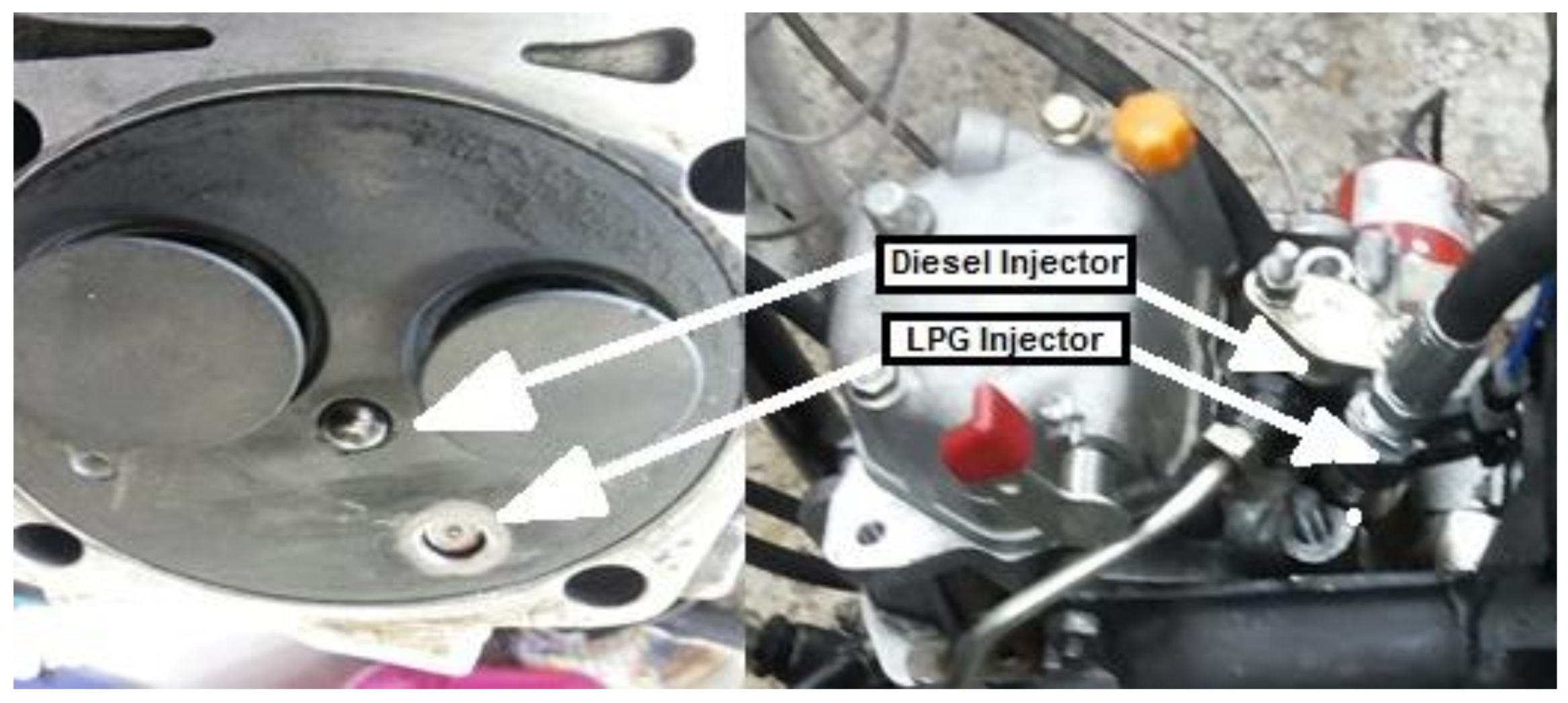

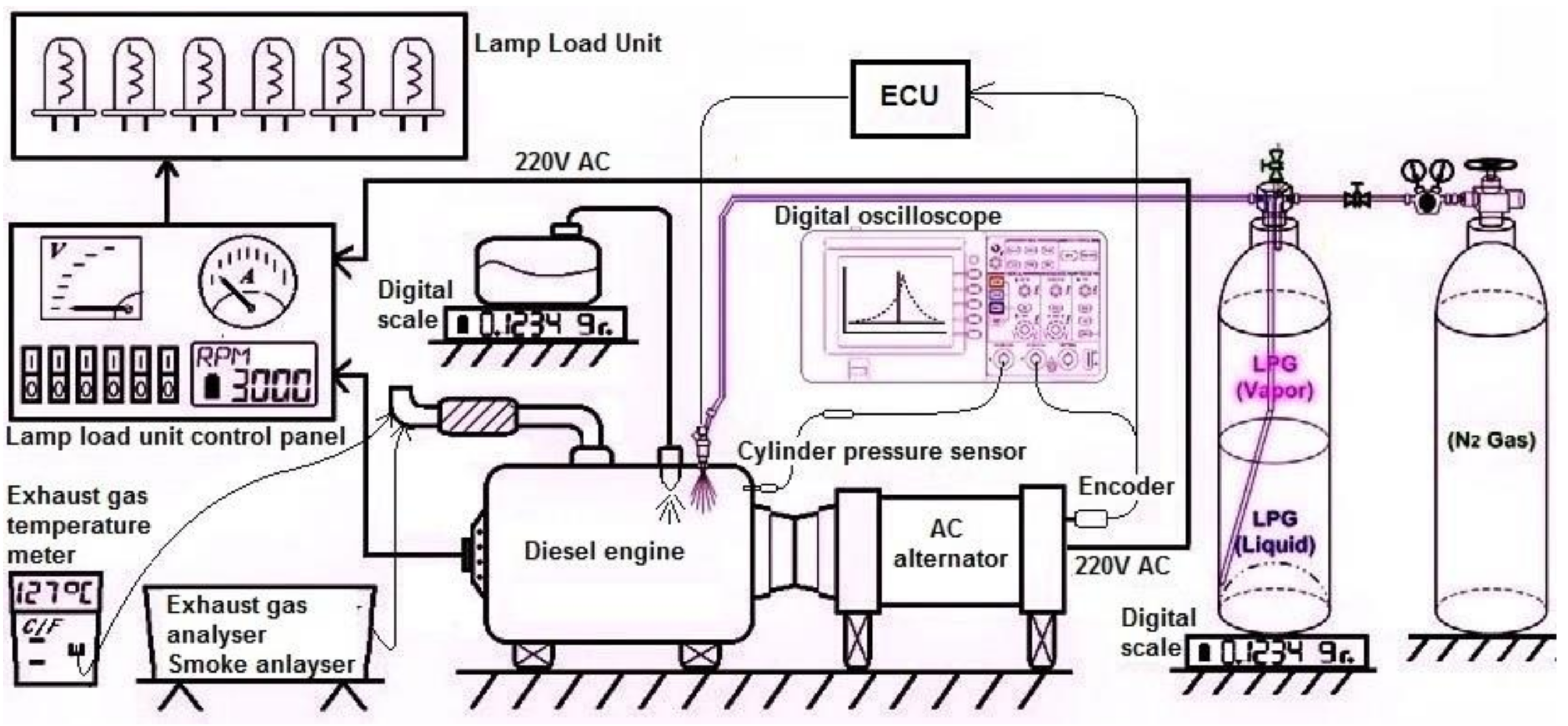
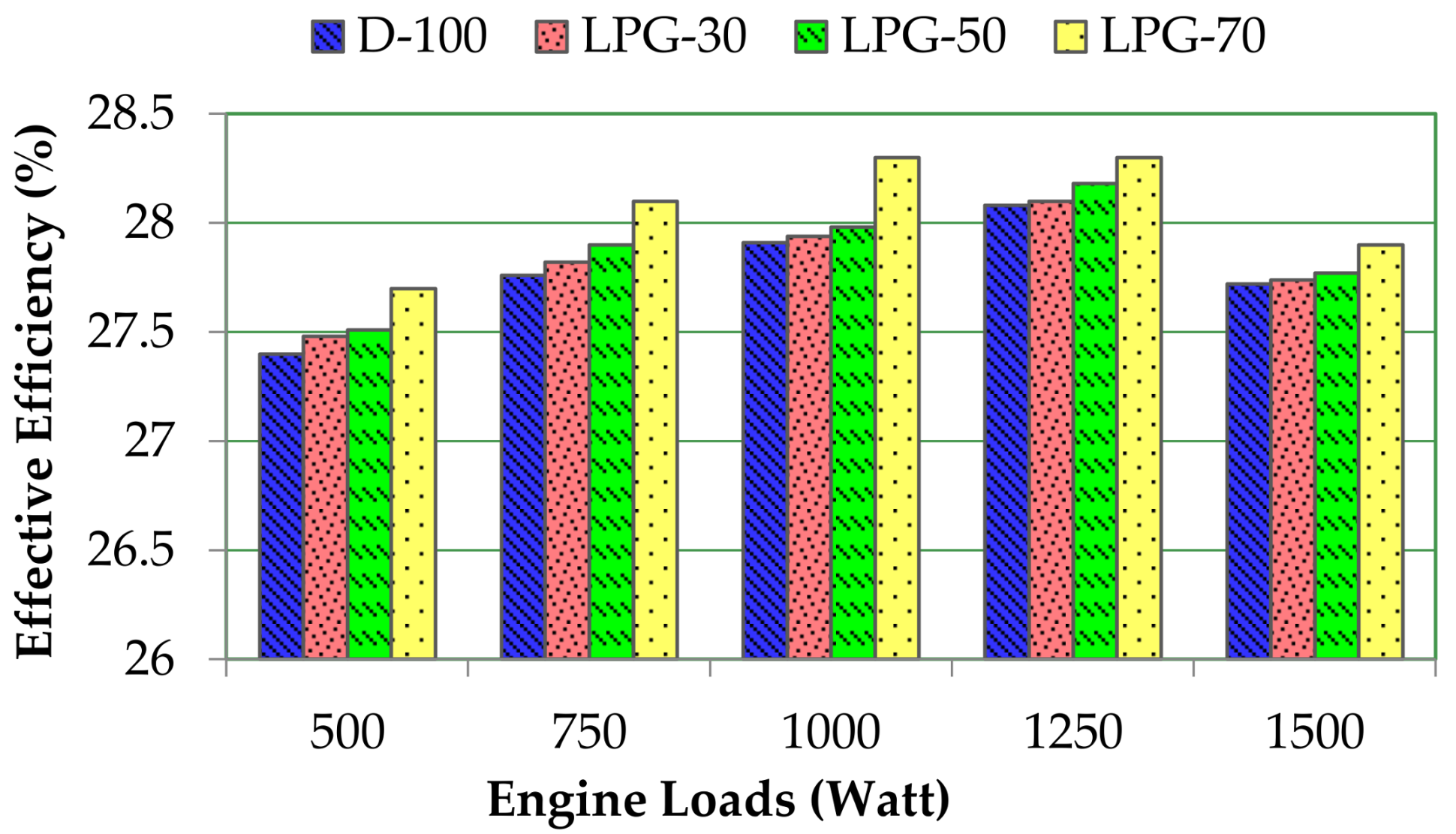
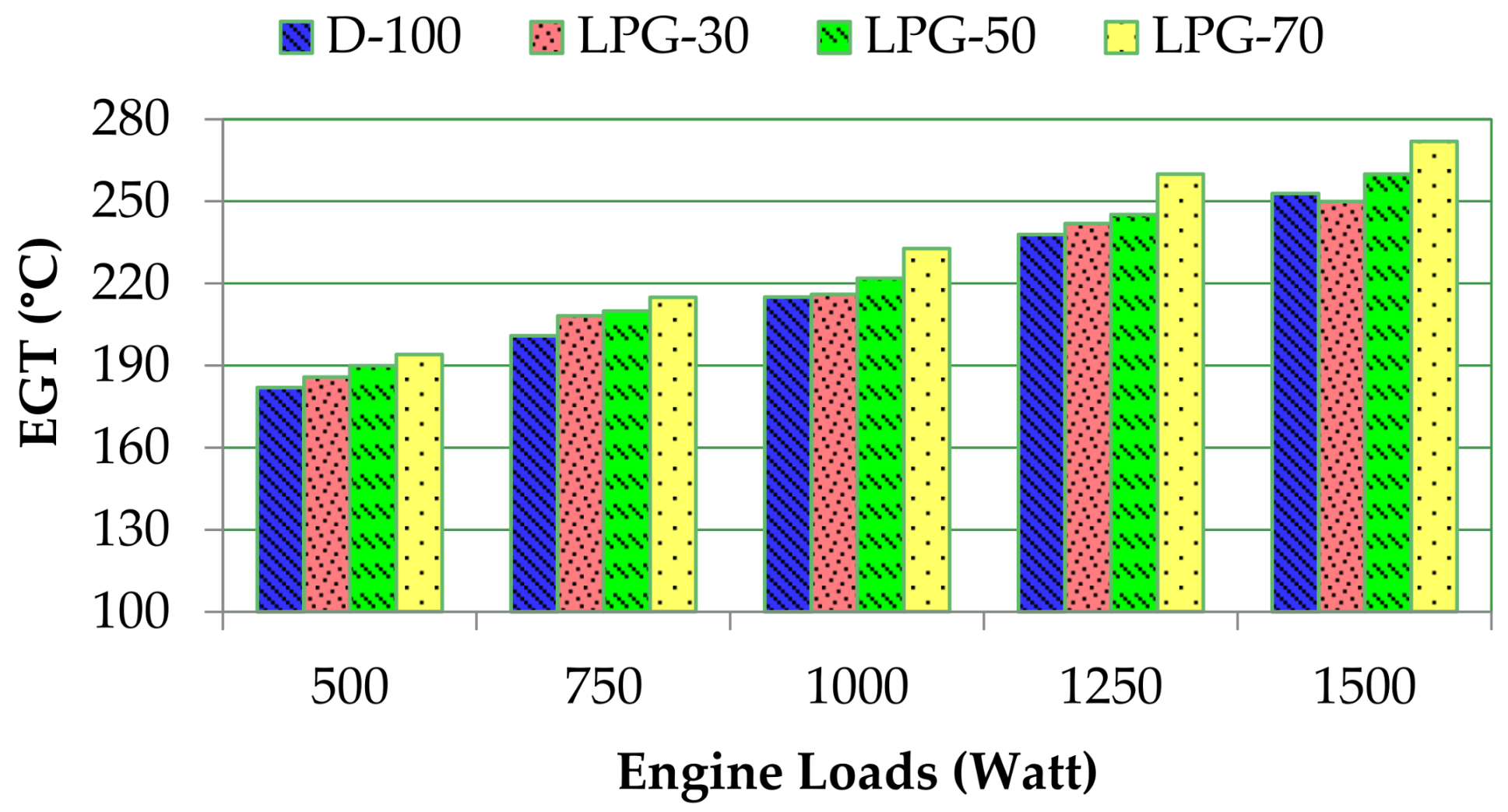
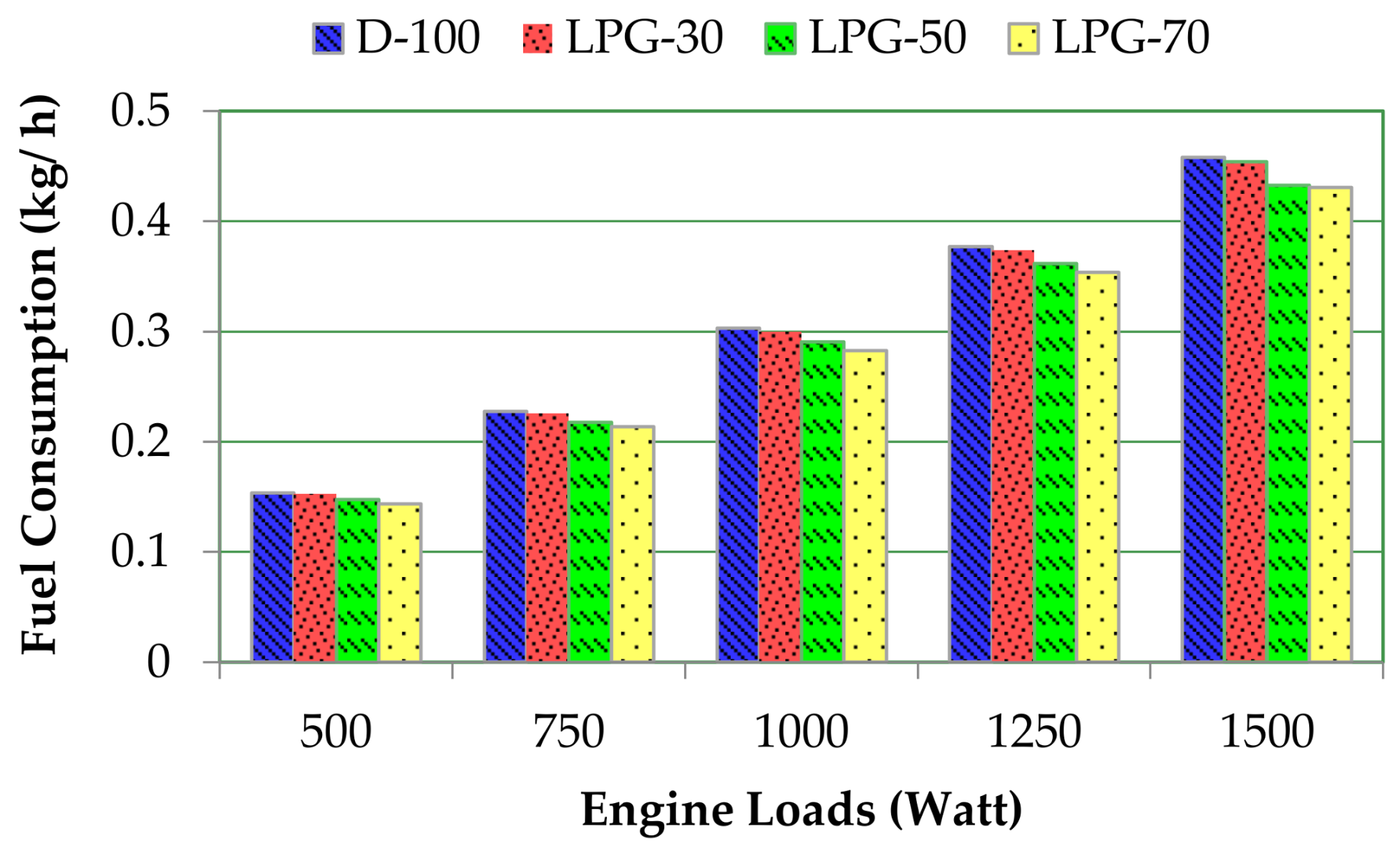
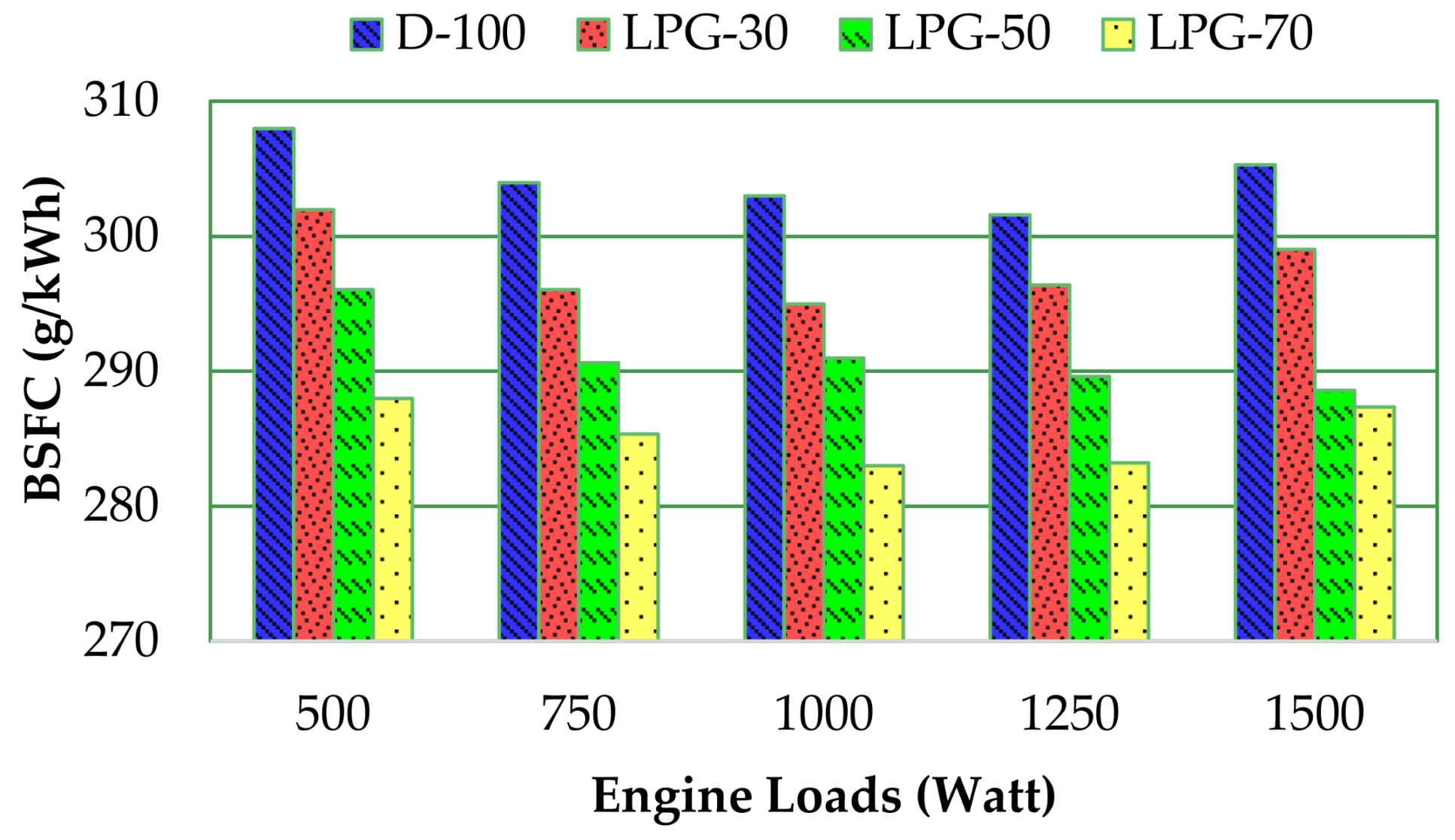
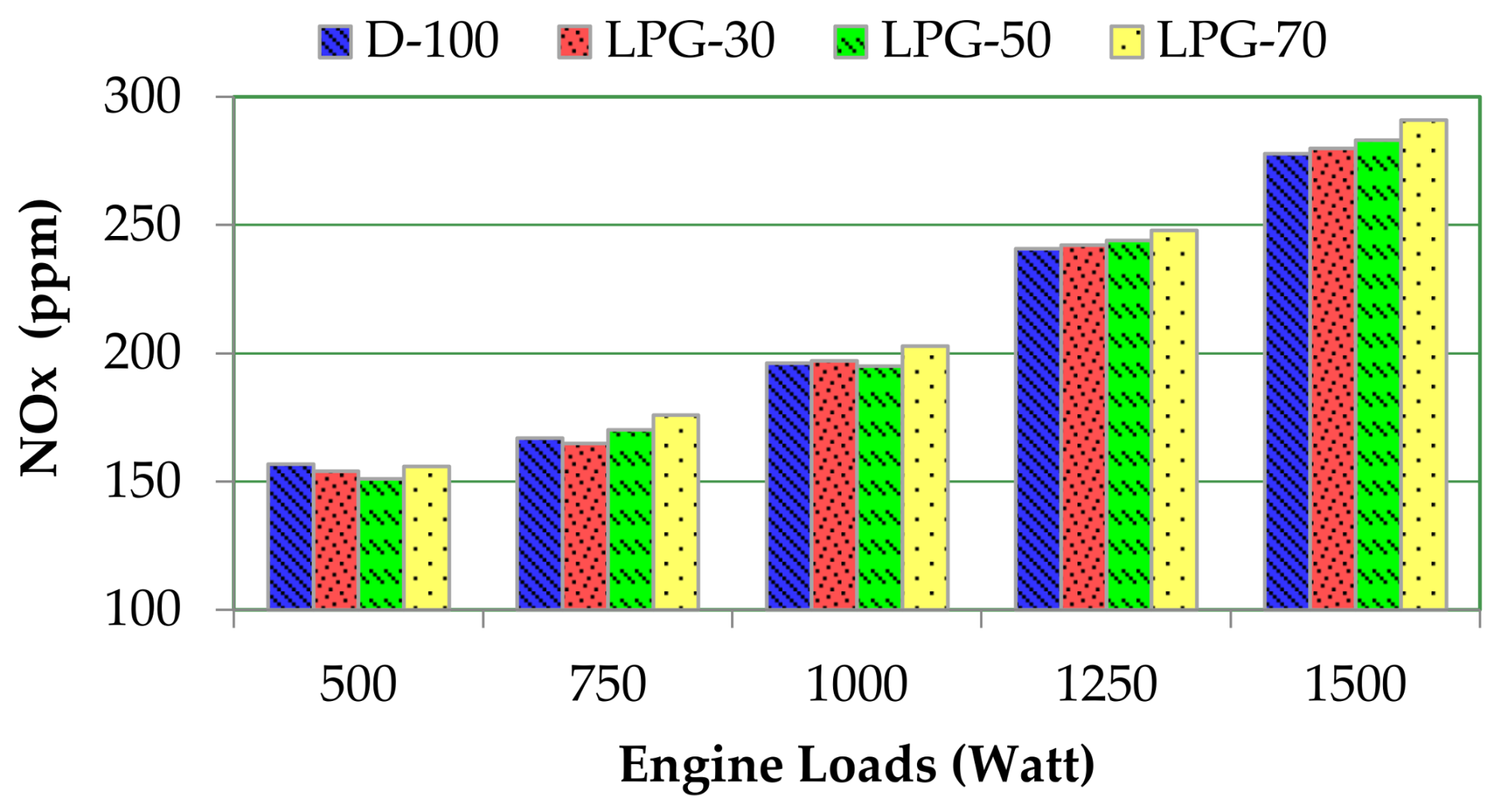
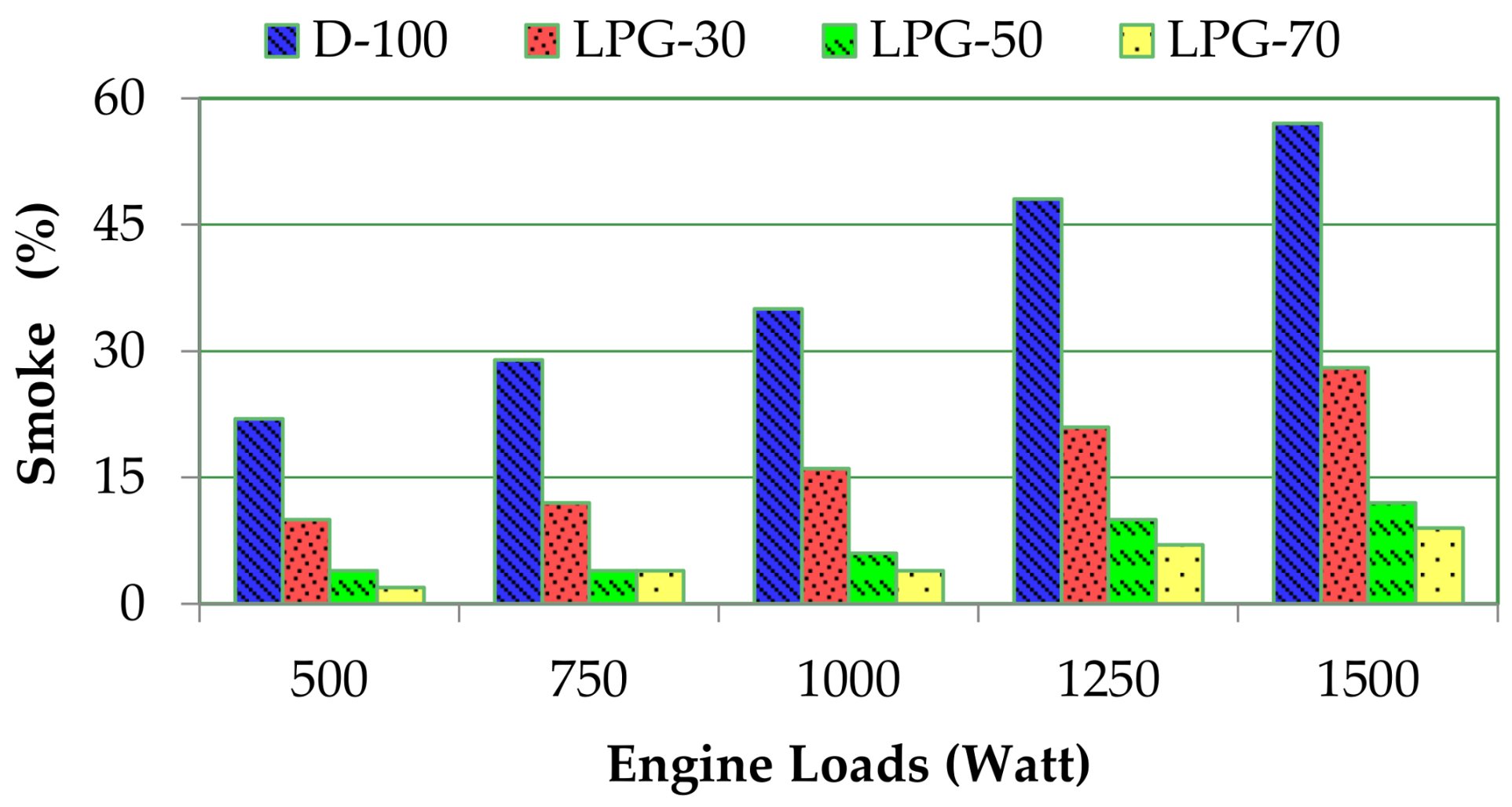
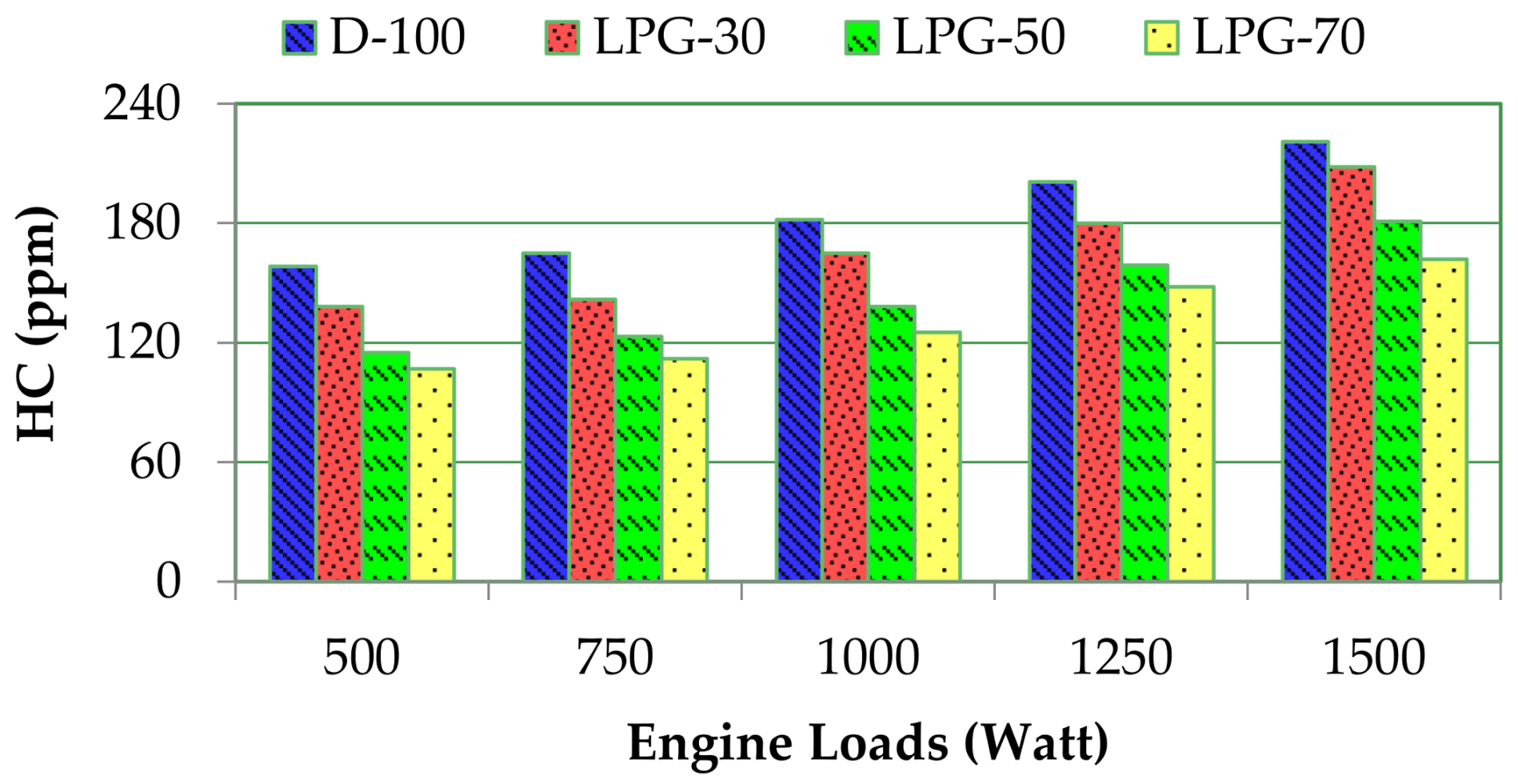
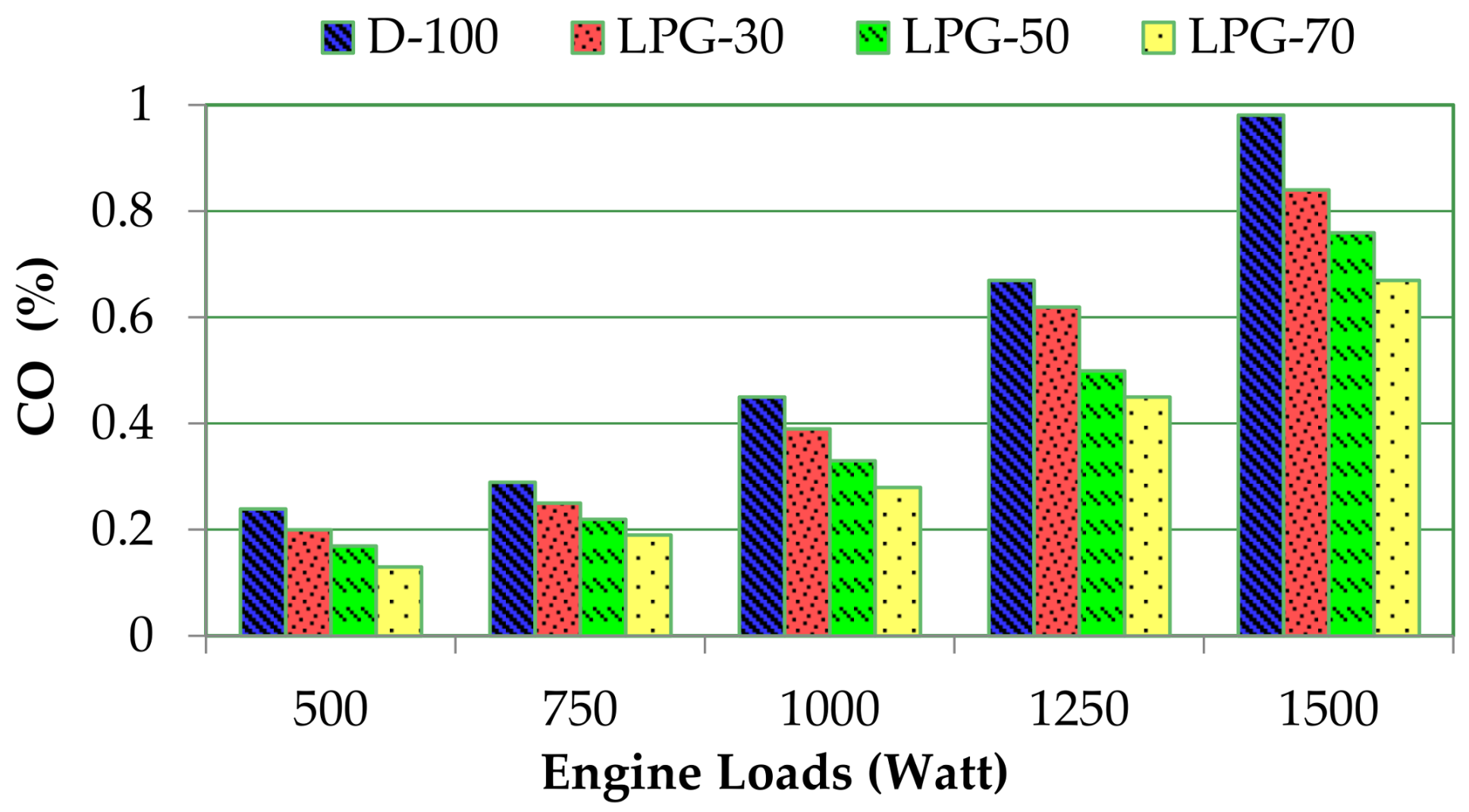
| Fuel | Diesel | LPG |
|---|---|---|
| Chemical Structure | C13H28 | %30 C3H8 + %70 C4H10 |
| Lower heating value (kJ/kg) | 42,500 | 45,908 |
| Autoignition temperature (°C) | 240 | 454 |
| Boiling point (°C) | 160–370 | −13 |
| Cetane index | 52 | 8 |
| Viscosity-kinematic @ 40 °C | 3 | 0.32 |
| Density (15 °C) (kg/L) | 0.83 | 0.560 |
| Latent heat of evaporation (MJ/kg) | 0.260 | 0.383 |
| Carbon/Hydrogen Ratio (C/H) | ~0.47 | 0.39 |
| Engine Specifications | Alternator Specifications | ||
|---|---|---|---|
| Manufacturer | Katana | Manufacturer | Katana |
| Engine Type | Km 178 Fe | Model | KD 4500 E |
| Diameter × Stroke | 78 × 62 | Maximum Power | 2.4 kVA |
| Cylinder Volume | 296 cm3 | Power | 6.3 kVA |
| Maximum Output Power | 7.6 hp | Phase | 1 |
| Continuous Output Power | 0.6 hp | Voltage | 230 VAC |
| Engine Speed | 3000 rpm | Frequency | 50 Hz |
| Measured Parameter | Measuring Method | Measuring Range | Accuracy |
|---|---|---|---|
| CO (%, v/v) | NDIR | 0~9.99 | 0.01 |
| HC (ppm) | NDIR | 0~2500 | 1 |
| NOx (ppm) | CLD | 0~2000 | 1 |
| Opacity (%) | NDIR | 0~99 | ±2 |
| Operating temperature (°C) | 5–40 | ||
| Operating Voltage (Vdc) | 12 |
© 2018 by the authors. Licensee MDPI, Basel, Switzerland. This article is an open access article distributed under the terms and conditions of the Creative Commons Attribution (CC BY) license (http://creativecommons.org/licenses/by/4.0/).
Share and Cite
Aydin, M.; Irgin, A.; Çelik, M.B. The Impact of Diesel/LPG Dual Fuel on Performance and Emissions in a Single Cylinder Diesel Generator. Appl. Sci. 2018, 8, 825. https://doi.org/10.3390/app8050825
Aydin M, Irgin A, Çelik MB. The Impact of Diesel/LPG Dual Fuel on Performance and Emissions in a Single Cylinder Diesel Generator. Applied Sciences. 2018; 8(5):825. https://doi.org/10.3390/app8050825
Chicago/Turabian StyleAydin, Mustafa, Ahmet Irgin, and M. Bahattin Çelik. 2018. "The Impact of Diesel/LPG Dual Fuel on Performance and Emissions in a Single Cylinder Diesel Generator" Applied Sciences 8, no. 5: 825. https://doi.org/10.3390/app8050825





